Reflective Report on Group Presentation
VerifiedAdded on 2020/02/12
|6
|1192
|111
Report
AI Summary
This report reflects on the experiences gained from a group presentation, utilizing Gibbs and Greenaway's reflective cycles to analyze communication skills and teamwork dynamics. It emphasizes the importance of effective communication and personal development within group settings.
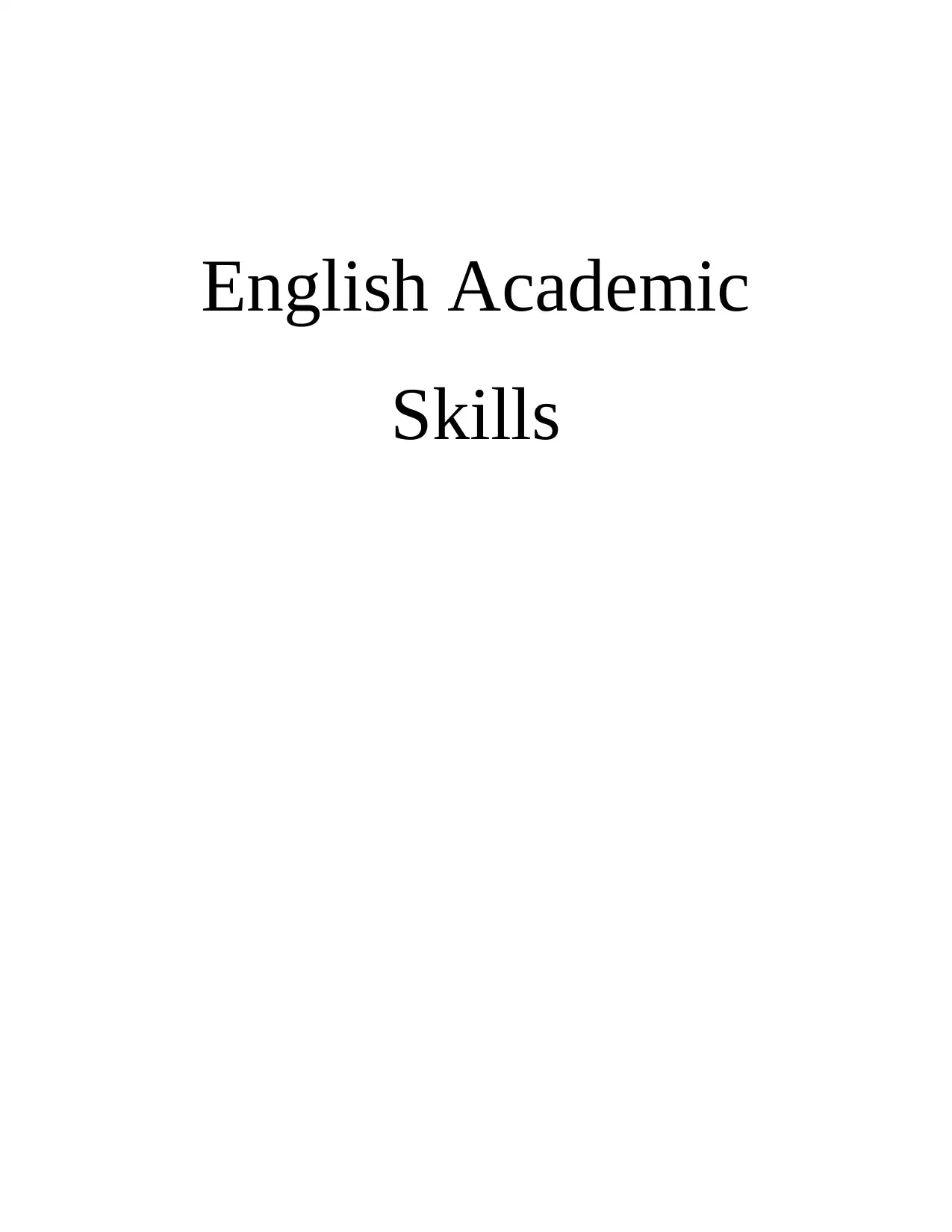
English Academic
Skills
Skills
Paraphrase This Document
Need a fresh take? Get an instant paraphrase of this document with our AI Paraphraser
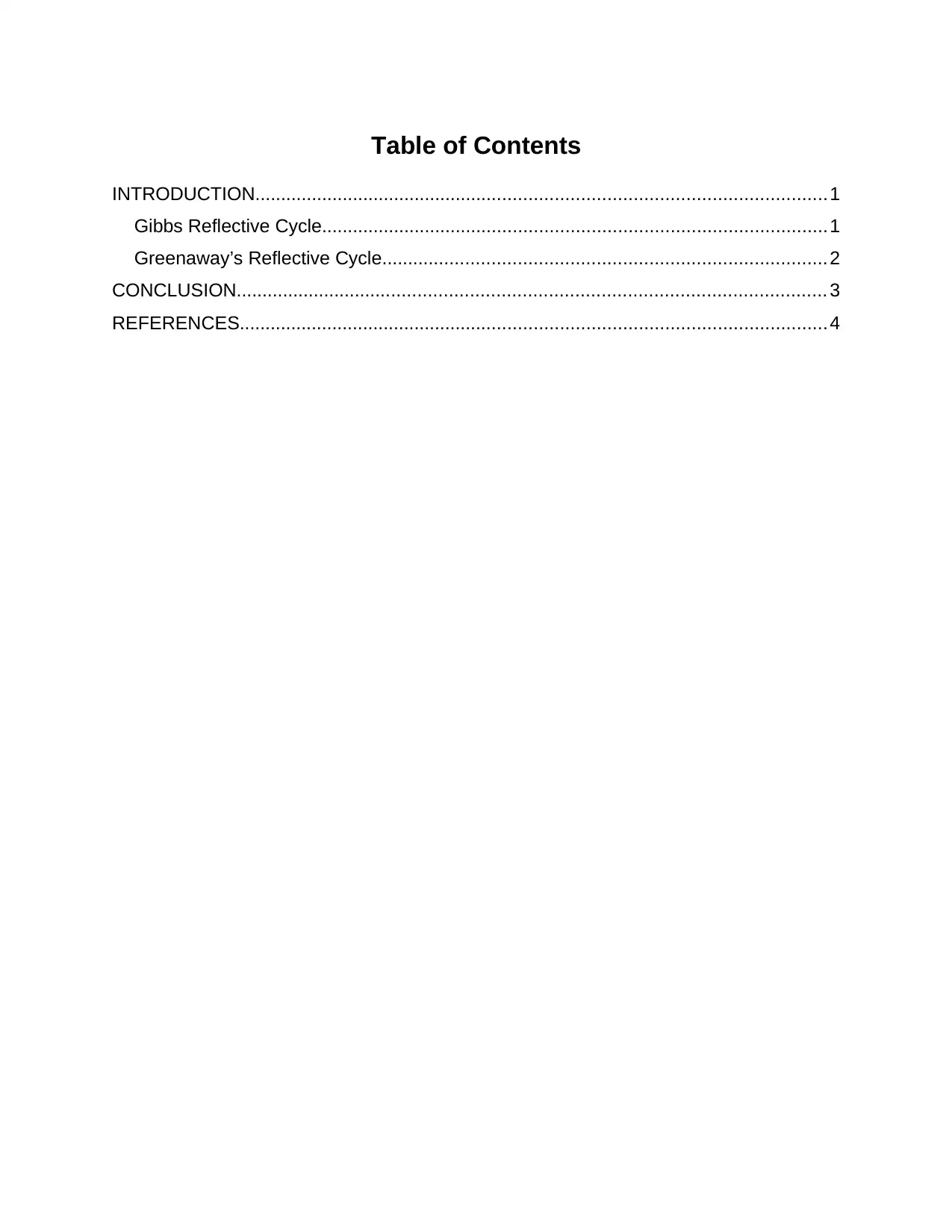
Table of Contents
INTRODUCTION..............................................................................................................1
Gibbs Reflective Cycle.................................................................................................1
Greenaway’s Reflective Cycle.....................................................................................2
CONCLUSION................................................................................................................. 3
REFERENCES.................................................................................................................4
INTRODUCTION..............................................................................................................1
Gibbs Reflective Cycle.................................................................................................1
Greenaway’s Reflective Cycle.....................................................................................2
CONCLUSION................................................................................................................. 3
REFERENCES.................................................................................................................4
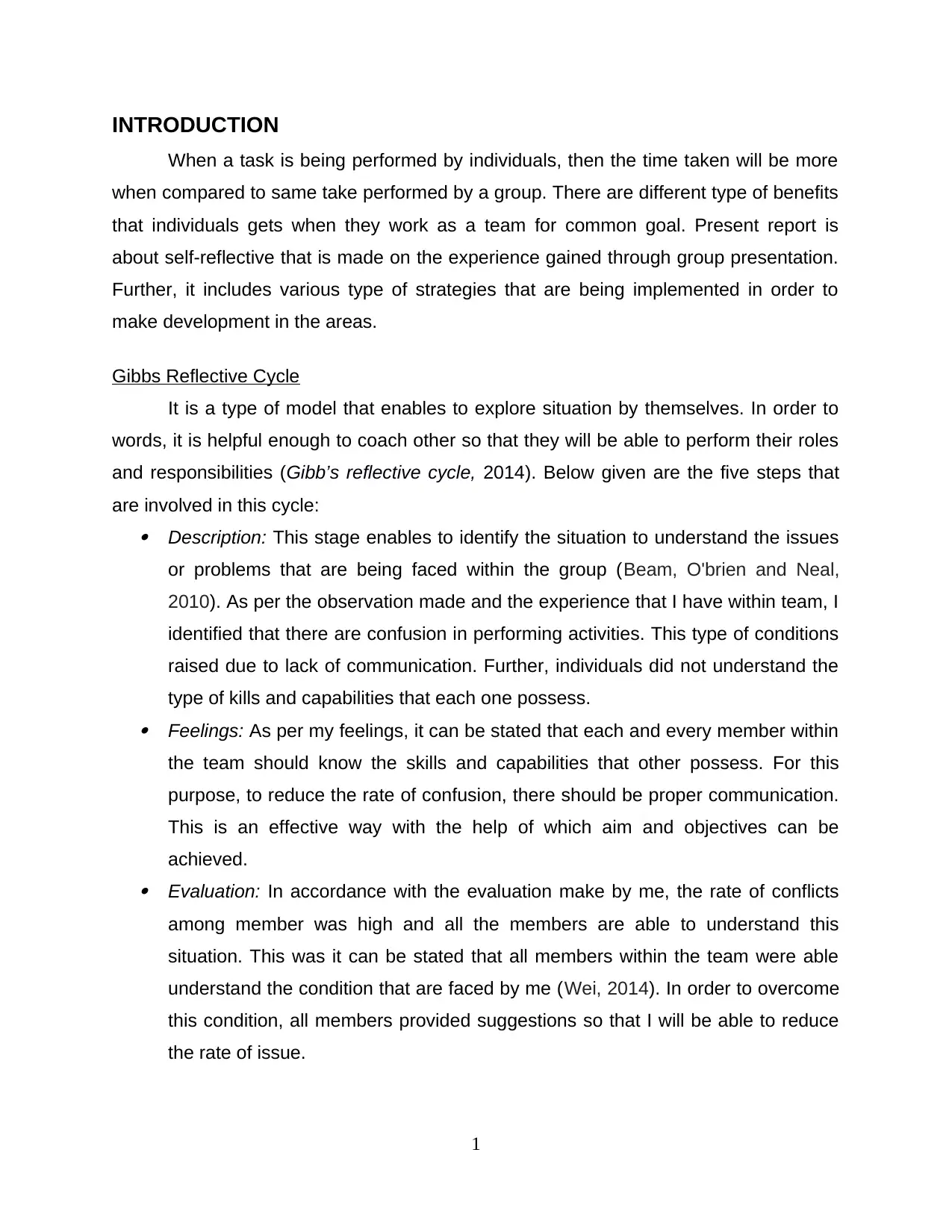
INTRODUCTION
When a task is being performed by individuals, then the time taken will be more
when compared to same take performed by a group. There are different type of benefits
that individuals gets when they work as a team for common goal. Present report is
about self-reflective that is made on the experience gained through group presentation.
Further, it includes various type of strategies that are being implemented in order to
make development in the areas.
Gibbs Reflective Cycle
It is a type of model that enables to explore situation by themselves. In order to
words, it is helpful enough to coach other so that they will be able to perform their roles
and responsibilities (Gibb’s reflective cycle, 2014). Below given are the five steps that
are involved in this cycle: Description: This stage enables to identify the situation to understand the issues
or problems that are being faced within the group (Beam, O'brien and Neal,
2010). As per the observation made and the experience that I have within team, I
identified that there are confusion in performing activities. This type of conditions
raised due to lack of communication. Further, individuals did not understand the
type of kills and capabilities that each one possess. Feelings: As per my feelings, it can be stated that each and every member within
the team should know the skills and capabilities that other possess. For this
purpose, to reduce the rate of confusion, there should be proper communication.
This is an effective way with the help of which aim and objectives can be
achieved. Evaluation: In accordance with the evaluation make by me, the rate of conflicts
among member was high and all the members are able to understand this
situation. This was it can be stated that all members within the team were able
understand the condition that are faced by me (Wei, 2014). In order to overcome
this condition, all members provided suggestions so that I will be able to reduce
the rate of issue.
1
When a task is being performed by individuals, then the time taken will be more
when compared to same take performed by a group. There are different type of benefits
that individuals gets when they work as a team for common goal. Present report is
about self-reflective that is made on the experience gained through group presentation.
Further, it includes various type of strategies that are being implemented in order to
make development in the areas.
Gibbs Reflective Cycle
It is a type of model that enables to explore situation by themselves. In order to
words, it is helpful enough to coach other so that they will be able to perform their roles
and responsibilities (Gibb’s reflective cycle, 2014). Below given are the five steps that
are involved in this cycle: Description: This stage enables to identify the situation to understand the issues
or problems that are being faced within the group (Beam, O'brien and Neal,
2010). As per the observation made and the experience that I have within team, I
identified that there are confusion in performing activities. This type of conditions
raised due to lack of communication. Further, individuals did not understand the
type of kills and capabilities that each one possess. Feelings: As per my feelings, it can be stated that each and every member within
the team should know the skills and capabilities that other possess. For this
purpose, to reduce the rate of confusion, there should be proper communication.
This is an effective way with the help of which aim and objectives can be
achieved. Evaluation: In accordance with the evaluation make by me, the rate of conflicts
among member was high and all the members are able to understand this
situation. This was it can be stated that all members within the team were able
understand the condition that are faced by me (Wei, 2014). In order to overcome
this condition, all members provided suggestions so that I will be able to reduce
the rate of issue.
1
⊘ This is a preview!⊘
Do you want full access?
Subscribe today to unlock all pages.

Trusted by 1+ million students worldwide
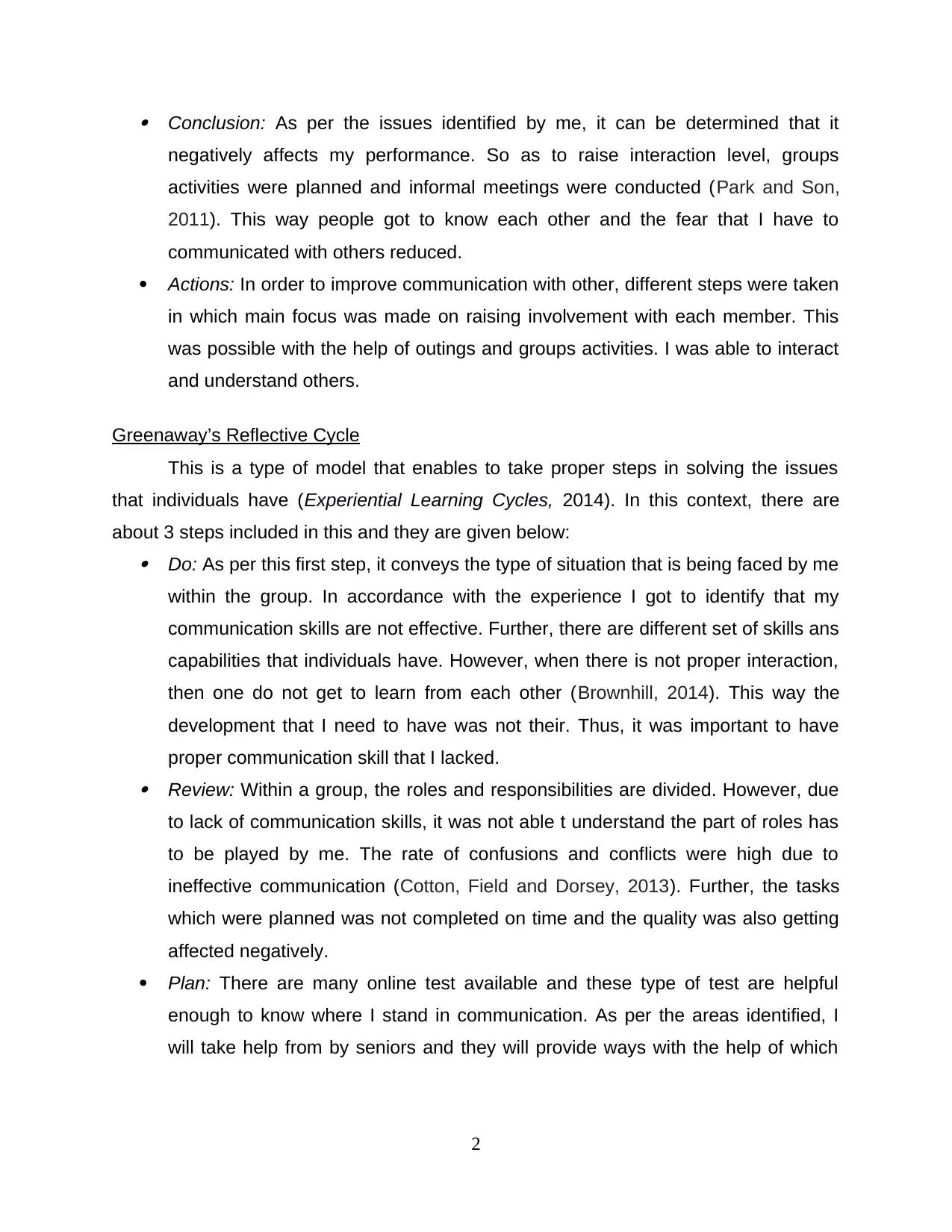
Conclusion: As per the issues identified by me, it can be determined that it
negatively affects my performance. So as to raise interaction level, groups
activities were planned and informal meetings were conducted (Park and Son,
2011). This way people got to know each other and the fear that I have to
communicated with others reduced.
Actions: In order to improve communication with other, different steps were taken
in which main focus was made on raising involvement with each member. This
was possible with the help of outings and groups activities. I was able to interact
and understand others.
Greenaway’s Reflective Cycle
This is a type of model that enables to take proper steps in solving the issues
that individuals have (Experiential Learning Cycles, 2014). In this context, there are
about 3 steps included in this and they are given below: Do: As per this first step, it conveys the type of situation that is being faced by me
within the group. In accordance with the experience I got to identify that my
communication skills are not effective. Further, there are different set of skills ans
capabilities that individuals have. However, when there is not proper interaction,
then one do not get to learn from each other (Brownhill, 2014). This way the
development that I need to have was not their. Thus, it was important to have
proper communication skill that I lacked. Review: Within a group, the roles and responsibilities are divided. However, due
to lack of communication skills, it was not able t understand the part of roles has
to be played by me. The rate of confusions and conflicts were high due to
ineffective communication (Cotton, Field and Dorsey, 2013). Further, the tasks
which were planned was not completed on time and the quality was also getting
affected negatively.
Plan: There are many online test available and these type of test are helpful
enough to know where I stand in communication. As per the areas identified, I
will take help from by seniors and they will provide ways with the help of which
2
negatively affects my performance. So as to raise interaction level, groups
activities were planned and informal meetings were conducted (Park and Son,
2011). This way people got to know each other and the fear that I have to
communicated with others reduced.
Actions: In order to improve communication with other, different steps were taken
in which main focus was made on raising involvement with each member. This
was possible with the help of outings and groups activities. I was able to interact
and understand others.
Greenaway’s Reflective Cycle
This is a type of model that enables to take proper steps in solving the issues
that individuals have (Experiential Learning Cycles, 2014). In this context, there are
about 3 steps included in this and they are given below: Do: As per this first step, it conveys the type of situation that is being faced by me
within the group. In accordance with the experience I got to identify that my
communication skills are not effective. Further, there are different set of skills ans
capabilities that individuals have. However, when there is not proper interaction,
then one do not get to learn from each other (Brownhill, 2014). This way the
development that I need to have was not their. Thus, it was important to have
proper communication skill that I lacked. Review: Within a group, the roles and responsibilities are divided. However, due
to lack of communication skills, it was not able t understand the part of roles has
to be played by me. The rate of confusions and conflicts were high due to
ineffective communication (Cotton, Field and Dorsey, 2013). Further, the tasks
which were planned was not completed on time and the quality was also getting
affected negatively.
Plan: There are many online test available and these type of test are helpful
enough to know where I stand in communication. As per the areas identified, I
will take help from by seniors and they will provide ways with the help of which
2
Paraphrase This Document
Need a fresh take? Get an instant paraphrase of this document with our AI Paraphraser
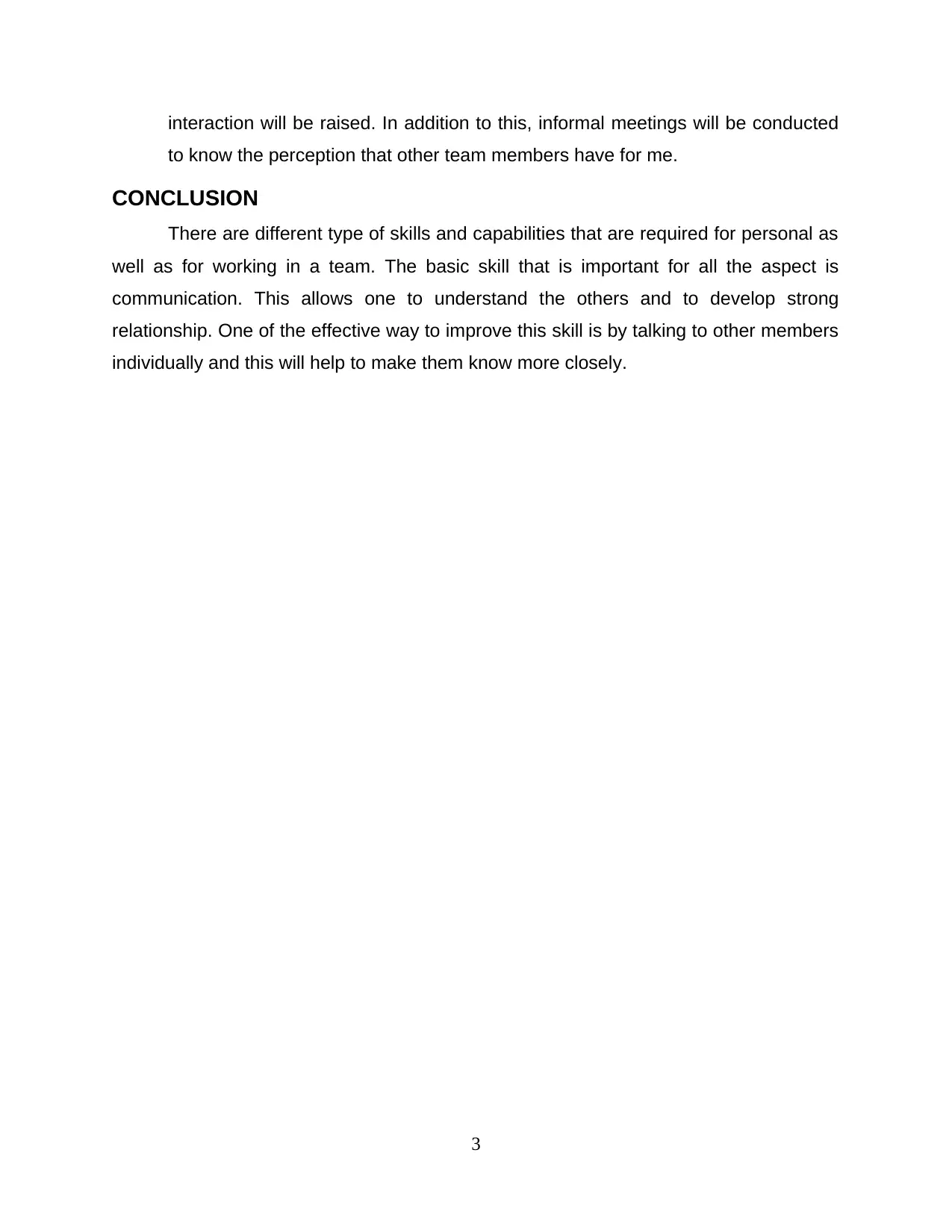
interaction will be raised. In addition to this, informal meetings will be conducted
to know the perception that other team members have for me.
CONCLUSION
There are different type of skills and capabilities that are required for personal as
well as for working in a team. The basic skill that is important for all the aspect is
communication. This allows one to understand the others and to develop strong
relationship. One of the effective way to improve this skill is by talking to other members
individually and this will help to make them know more closely.
3
to know the perception that other team members have for me.
CONCLUSION
There are different type of skills and capabilities that are required for personal as
well as for working in a team. The basic skill that is important for all the aspect is
communication. This allows one to understand the others and to develop strong
relationship. One of the effective way to improve this skill is by talking to other members
individually and this will help to make them know more closely.
3
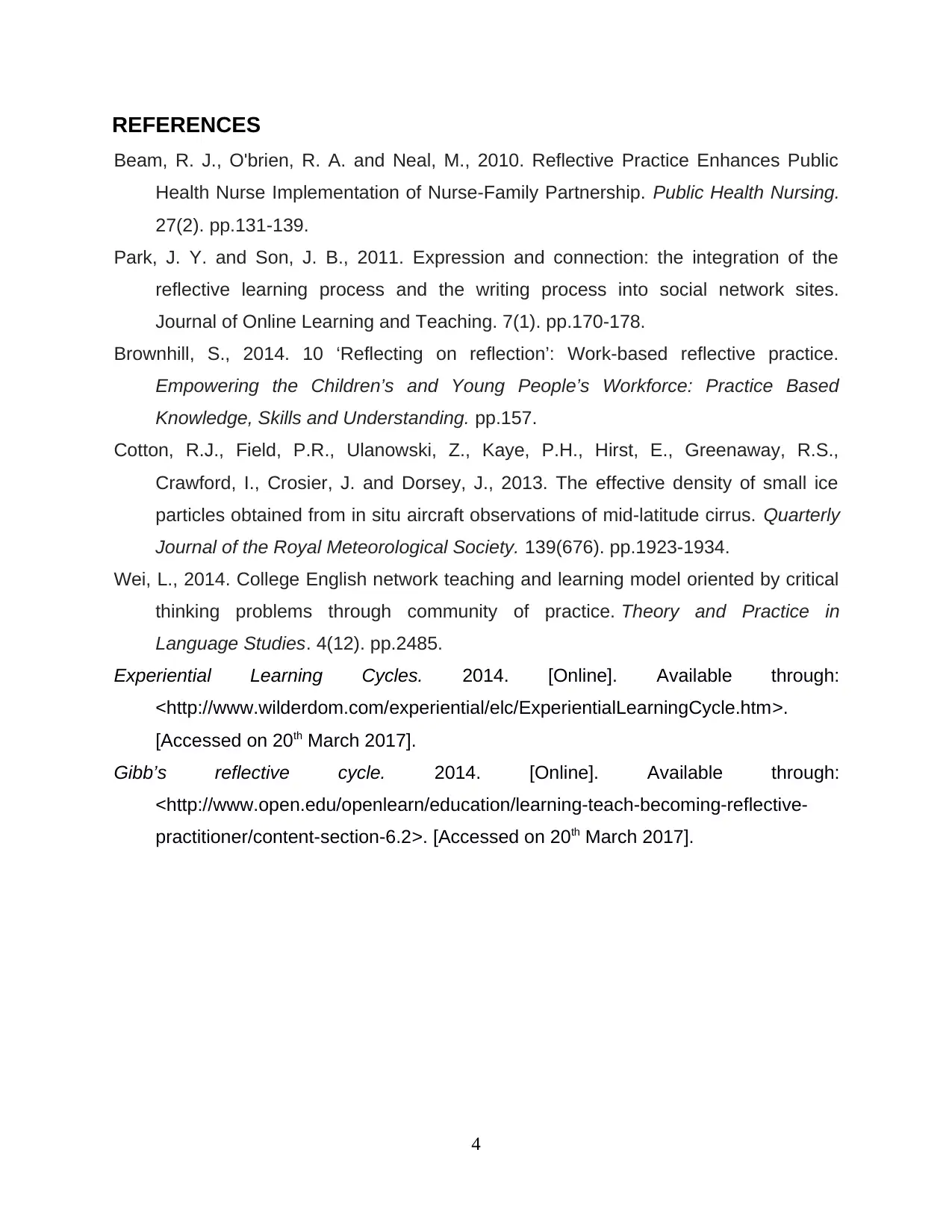
REFERENCES
Beam, R. J., O'brien, R. A. and Neal, M., 2010. Reflective Practice Enhances Public
Health Nurse Implementation of Nurse‐Family Partnership. Public Health Nursing.
27(2). pp.131-139.
Park, J. Y. and Son, J. B., 2011. Expression and connection: the integration of the
reflective learning process and the writing process into social network sites.
Journal of Online Learning and Teaching. 7(1). pp.170-178.
Brownhill, S., 2014. 10 ‘Reflecting on reflection’: Work-based reflective practice.
Empowering the Children’s and Young People’s Workforce: Practice Based
Knowledge, Skills and Understanding. pp.157.
Cotton, R.J., Field, P.R., Ulanowski, Z., Kaye, P.H., Hirst, E., Greenaway, R.S.,
Crawford, I., Crosier, J. and Dorsey, J., 2013. The effective density of small ice
particles obtained from in situ aircraft observations of mid‐latitude cirrus. Quarterly
Journal of the Royal Meteorological Society. 139(676). pp.1923-1934.
Wei, L., 2014. College English network teaching and learning model oriented by critical
thinking problems through community of practice. Theory and Practice in
Language Studies. 4(12). pp.2485.
Experiential Learning Cycles. 2014. [Online]. Available through:
<http://www.wilderdom.com/experiential/elc/ExperientialLearningCycle.htm>.
[Accessed on 20th March 2017].
Gibb’s reflective cycle. 2014. [Online]. Available through:
<http://www.open.edu/openlearn/education/learning-teach-becoming-reflective-
practitioner/content-section-6.2>. [Accessed on 20th March 2017].
4
Beam, R. J., O'brien, R. A. and Neal, M., 2010. Reflective Practice Enhances Public
Health Nurse Implementation of Nurse‐Family Partnership. Public Health Nursing.
27(2). pp.131-139.
Park, J. Y. and Son, J. B., 2011. Expression and connection: the integration of the
reflective learning process and the writing process into social network sites.
Journal of Online Learning and Teaching. 7(1). pp.170-178.
Brownhill, S., 2014. 10 ‘Reflecting on reflection’: Work-based reflective practice.
Empowering the Children’s and Young People’s Workforce: Practice Based
Knowledge, Skills and Understanding. pp.157.
Cotton, R.J., Field, P.R., Ulanowski, Z., Kaye, P.H., Hirst, E., Greenaway, R.S.,
Crawford, I., Crosier, J. and Dorsey, J., 2013. The effective density of small ice
particles obtained from in situ aircraft observations of mid‐latitude cirrus. Quarterly
Journal of the Royal Meteorological Society. 139(676). pp.1923-1934.
Wei, L., 2014. College English network teaching and learning model oriented by critical
thinking problems through community of practice. Theory and Practice in
Language Studies. 4(12). pp.2485.
Experiential Learning Cycles. 2014. [Online]. Available through:
<http://www.wilderdom.com/experiential/elc/ExperientialLearningCycle.htm>.
[Accessed on 20th March 2017].
Gibb’s reflective cycle. 2014. [Online]. Available through:
<http://www.open.edu/openlearn/education/learning-teach-becoming-reflective-
practitioner/content-section-6.2>. [Accessed on 20th March 2017].
4
⊘ This is a preview!⊘
Do you want full access?
Subscribe today to unlock all pages.

Trusted by 1+ million students worldwide
1 out of 6
Related Documents
Your All-in-One AI-Powered Toolkit for Academic Success.
+13062052269
info@desklib.com
Available 24*7 on WhatsApp / Email
![[object Object]](/_next/static/media/star-bottom.7253800d.svg)
Unlock your academic potential
Copyright © 2020–2025 A2Z Services. All Rights Reserved. Developed and managed by ZUCOL.




